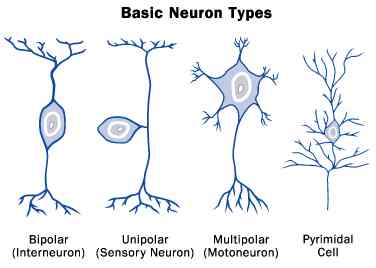Prevents backflow of blood from ventricles to atria. Prevents backflow from large arteries to ventricles.
What is bicuspid/tricuspid valves and semilunar valves?
Nervous tissue is composed of two basic cells. Describe them.
What are neurons and glial cells?
Neurons: specialized for conducting electrical impulses (communication)
Glial Cells: Provide Functional and structural support for neurons
Components of the CNS.
What is the brain and spinal cord?
Components of the PNS.
What are structures outside of the CNS (i.e. nerves, ganglia).
What are rods and cones.
Initiates and paces contractions. Specialized cells in superior part of RA. Spontaneously depolarize (generate electrical signal) at regular intervals. Wave of depolarization (electrical signal) spreads across atria causing the atria to contract.
What is the sinoatrial node?
Describe the parts of the neuron.
What are the dendrites (receive and integrate signals), cell body (houses organelles receives and integrates signals), and axon (sends signals to target cells)?
Describe the layers of the meninges from outermost to innermost.
What is .....
Dura Mater: tough, outer layer
Arachnoid Mater: middle thin layer (spider web like)
Pia Mater: very thin, on surface of brain and spinal cord
Describe somatic motor pathways.
What is....
--efferent neuron from CNS (spinal cord) to effector (skeletal muscle)
--single neuron in pathway
--cell body of neuron in spinal cord (or brain)
--single long axon to muscle
--axon branches close to target
--divides into cluster of axon terminals
--branches innervate multiple muscle fibers (motor unit)
--usually one region of contact with muscle fiber
Sensory receptors based on the type of info they are gathering.
What are.....
PROPRIOCEPTORS: body position & movement, mechanoreceptors
NOCICEPTORS: noxious or harmful stimulus, interpreted as pain, may be mechanoreceptors, chemoreceptors, or thermoreceptors, gather info about injuries
Describe blood flow.
What is...

Describe the types of neurons.
What are....
UNIPOLAR: somatic sensory neurons
BIPOLAR: in eye
MULTIPOLAR: motor neurons to muscles
PYRAMIDAL CELLS: in brain

Describe the numbering of spinal nerves.
What is....
The spinal nerves are numbered according to the vertebrae above which it exits the spinal canal. The 8 cervical spinal nerves are C1 through C8, the 12 thoracic spinal nerves are T1 through T12, the 5 lumbar spinal nerves are L1 through L5, and the 5 sacral spinal nerves are S1 through S5.

Describe the enteric nervous system.
What is.....
--regulates digestive reflexes
--includes sensory neurons, interneurons, motor neurons
--myenteric (Auerbach’s) plexus: regulates smooth muscle of digestive tract
--submucosal (Meissner’s) plexus: regulates secretion; monitors chemical environment
Detects horizontal acceleration and deceleration. Detects vertical acceleration and deceleration
What is utricle and saccule?
Describe the double loop circuit.
 What is....
What is....
Describe the glial cells of the PNS and CNS.
What are...
CNS:
ASTROCYTES:
-star shaped, provides structural support, takes up neurotransmitter from chemical synapse
-stores glucose as glycogen for use by neurons
-regulates ionic environment
-contributes to blood-brain barrier
OLIGODENDROCYTES:
-provides structural support
-have processes that help myelinate axons in the CNS
MICROGLIA:
-remove waste, pathogens, and debris
-extend processes that seek things that do not belong
-when something is found , processes are retracted and cell moves toward it
-important for defense functions
Ependymal Cells
-Lines spaces within brain and spinal cord
-aid in producing, circulating, and monitoring cerebrospinal fluid
-neural stem cells are located in the ependymal layer
PNS:
Satellite Cells
-provides physical support for neuron cell bodies
-provide nutrients to neurons; regulate ionic environment
Schwann Cells
-myelination; entire cell creates myelin sheath
Describe all the structures and regions during development of the brain.
What is.....
PROSENCEPHALON: (forebrain)
TELENCEPHALON: cerebral hemispheres, olfactory bulb
DIENCEPHALON: epithalamus, thalamus, hypothalamus
MESENCEPHALON (midbrain)
TECTUM: roof, sensory
TEGMENTUM: floor, motor
RHOMBOCEPHALON: (hindbrain)
METENCEPHALON: pons, cerebellum
MYELENCEPHALON: medulla oblongata
Chain ganglia is found where. Is it paired or unpaired?
What is sympathetic division and paired.
Single row that processes auditory stimulus and has a high degree of innervation. Three rows that contains motor proteins in cell membrane, increase movement of basilar membrane, and increase sensitivity (able to detect greater range of frequencies).
What is inner hair cells and outer hair cells.
Describe newborn circulation.
What is...
DUCTUS ARTERIOSUS (diverts blood from pulmonary trunk to aorta; only small amount of blood continues in lungs) CLOSES, becomes the ligamentum arteriosum
FORAMEN OVALE (diverts blood from RA to LA; slightly less than half of the blood in RA goes through foramen ovale; blood is directed to the left side of the heart which pumps it to systemic circulation) CLOSES, becomes fossa ovalis
Fetal circulation (to and from placenta)
Ductus venosus becomes ligamentum venosum
umbilical vein becomes ligamentum teres
umbilical arteries becomes medial umbilical ligaments
Remember (internal iliac arteries----umbilical arteries-----placenta-----umbilical vein (unpaired)-------hepatic portal vein to liver/ through ductus venosus to IVC to heart
Describe what each of these words mean....
in the CNS: tract, nucleus, and cortex
in the PNS: nerve and ganglion
What is....
In the CNS:
Tract: bundles/ collections of axons (transmission of info), white matter
Nucleus: clusters/collections of neuron cell bodies (integration of info), gray matter
Cortex: sheet of neuron cell bodies (integration), gray matter
IN THE PNS:
Nerve: Collection/bundles of axons (transmission), white matter
Ganglion: clusters/collection of neuron cell bodies (integration), gray matter
Describe the three fibers that are located within white matter.
What are...
COMISSURAL FIBERS: connect hemispheres (corpus callosum= anterior commissure)
ASSOCIATION FIBERS: connect regions of cerebral cortex in same hemisphere
PROJECTION FIBERS: connect cerebral cortex to other brain area in same hemisphere
Similarities between sympathetic and parasympathetic pathways.
What is........
--comprised of two neurons in sequence
--acetylcholine released from preganglionic to postganglionic neuron
--neurons synapse at an autonomic ganglion
--preganglionic neuron is myelinated
--post-ganglionic neuron is not myelinated
--several connections within ganglion (axons can have multiple branches)
--form neuroeffector junction with target
--neurotransmitter released from varicosities
--receptors scattered along effector
--neurotransmitter is broadcast across target
This vibrates in response to pressure waves. This is filled with air. These transmit and amplify vibrations. All of the above statements are found here.
What is tympanic membrane, tympanic cavity, auditory ossicles (malleus, incus, and stapes), and middle ear.